According to world statistics, back pain ranks second after viral infections on the list of causes of disability. They are at the top of the hospital visit list. Contrary to popular belief that most older people suffer from them, the back often hurts in the younger generation. Why does your back hurt, what preventive measures should be taken to avoid this, and what exercises will help with the pain; we will consider these and other questions in this article.
Causes
Since the back is a fairly large area of the human body and many vital organs (heart, lungs, intestines, kidneys) project onto it, there can be many causes of pain. Especially often they are localized in the lumbar region.
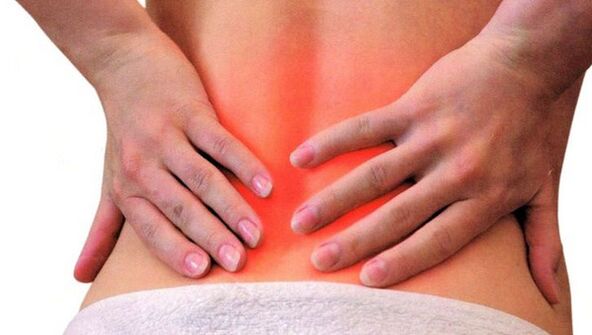
The main reasons why your back hurts can be:
- Injuries to muscles and ligaments: overexertion, sprain, spasm, hypothermia, contusion.
- Spinal diseases: herniated intervertebral discs, scoliosis, osteochondrosis, osteoarthritis of the facet joints, pinched nerves, displacement of the vertebrae, sciatica, lumbago.
- Diseases of the internal organs: kidneys, heart, gastrointestinal tract, small pelvis.
Also, pain in the back of the body accompanies a heart attack, stroke.
Even with mild but frequent back pain, it is necessary to consult a doctor to prevent the development of a more serious disease. So, for example, the displacement of the vertebrae can lead to osteochondrosis or hernia.
The risk group for back problems accompanied by painful sensations includes people who:
- work sitting or standing (for example, drivers; those who work at the computer);
- cope with great physical activity;
- often experiences stressful situations;
- train hard in gyms;
- Have overweight;
- having a wrong posture.
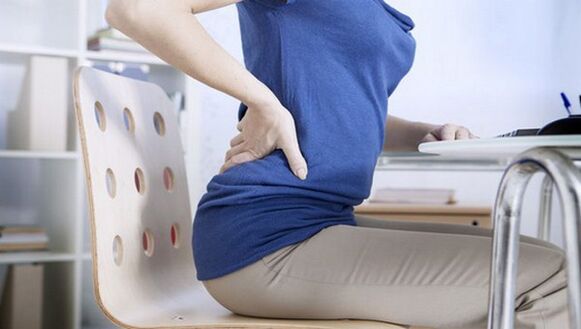
Symptoms
The discomfort can be localized in different parts of the back, but most often appear in the following parts of the body.
In the lumbar area. As a rule, back pain in the lumbar region is painful, obsessive, pulling, its reasons can be:
- intervertebral hernia;
- osteochondrosis;
- radiculitis;
- female diseases;
- outgoing;
- kidney problems
Pain can be given to the leg, it becomes stronger when a person is sitting or walking. In this case, it may be due to an inflammation of the sciatic nerve.
If a pregnant woman feels so much pain, after the birth of a child, she should conduct a serious examination of the spine:
- In the back of the head, it turns into a headache.Most likely, she will need to pay attention to the examination of the cervical vertebrae. Also, neck problems are indicated by pain in the neck area and back at the same time. She feels herself turning and tilting her head.
- On the scapula and in the center of the spine.It can increase with inhalation and when a person turns the trunk. The reason must be sought in the work of the heart and the thoracic spine.
- Center back- Acute pain radiating to the chest, heart. The probable cause is neuralgia or problems with an internal organ.
- Between the shoulder blades.If the back between the shoulder blades hurts slightly, but obsessively, the reasons most likely lie in intercostal neuralgia, osteochondrosis, scoliosis, other problems of the spine, as well as diseases of the stomach, gallbladder, the lungs and liver.
- In the lower part of the torso.If such pain is sharp and is accompanied by an increase in temperature, then it is similar to renal colic or other diseases of the kidneys and genitourinary system.
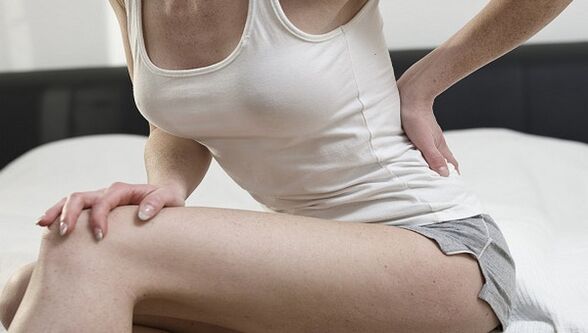
The most dangerous back pain is the one that radiates to the thoracic region, since it can be evidence of a heart attack. The most common is a painful discomfort in the spine. Neck pain is the most troublesome to treat.
When to see a doctor
Back pain can occur after lifting heavy objects or making sudden movements. They can be removed with massages or special ointments. If the pain recurs or accompanies a person constantly, he should go to the doctor. A neurologist will help determine the causes. By correctly identifying the cause and eliminating it, you can permanently get rid of back discomfort.
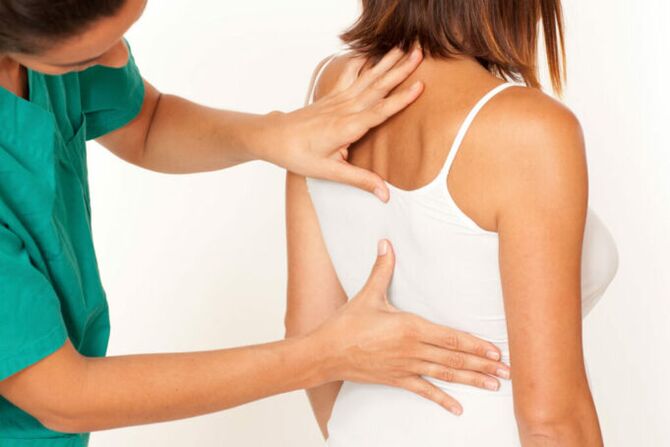
Inopportune treatment is fraught with serious consequences, including surgical intervention.
Don't put off a visit to the doctor when pain:
- acute and does not stop for two or three days;
- constant, which does not pass for two weeks;
- sharp, for no reason;
- accompanied by high fever, stomach cramps, chest pain, respiratory complications;
- gives in leg;
- appeared after the injury.
It is imperative and immediately necessary to call an ambulance if, along with pain in the back, a person finds it difficult to move, has confusion or loss of consciousness, shock.
Methods for diagnosing back pain.
A specialist will help accurately determine the cause based on the results of the diagnosis, which is carried out using such methods:
- ultrasound examination (ultrasound);
- magnetic resonance imaging (MRI);
- electrocardiogram (ECG);
- bone scan;
- laboratory research.
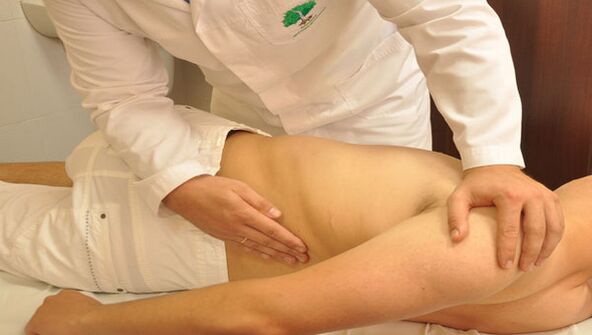
Treatment methods
Treatment methods can be roughly divided into traditional and non-traditional. And also for medication, neurosurgical and conservative. Consider them in more detail.
Traditional
Drug treatment methods are aimed, first of all, at relieving pain and inflammation, improving metabolic processes. The pain is relieved with the help of painkillers in the form of tablets and in the form of injections and droppers.
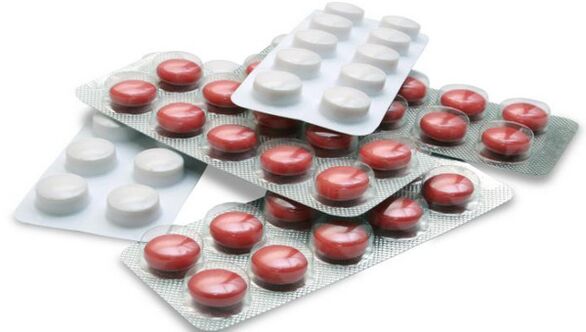
In the complex, vitamins C, B and immunomodulators are prescribed. In more difficult cases, injections are given to help relieve pain and have an anti-inflammatory effect.
Physiotherapeutic procedures are mandatory for painful sensations in the back associated with diseases of the spine, joints, nervous system and the consequences of injuries:
- laser therapy;
- Beam of light;
- ultrasound;
- electrophoresis;
- ultraviolet;
- magnetic;
- infrared radiation;
- electromagnetic waves.
This also includes mud treatment.
Another traditional treatment is massage. Is recommended:
- with osteochondrosis;
- arthritis;
- osteoarthritis;
- radiculitis;
- intense physical exertion;
- curvature of the spine,
- hernia.
In addition to relieving pain, massage also helps correct posture, improve blood circulation, restore immunity, improve the functioning of internal organs, and relax the nervous system.
Statistics show that 50% of patients after the first attack of back pain, if they do not seek medical help in a timely manner, experience repeated attacks or begin to suffer from chronic diseases.
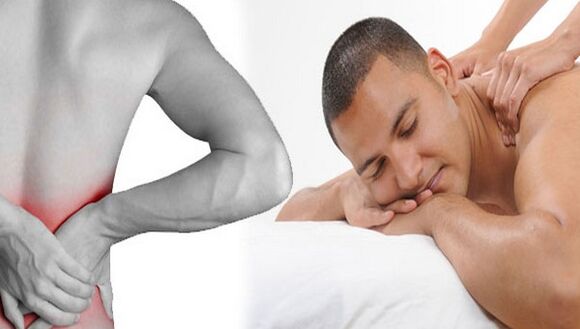
There are three types of massage:
- Classic (all massage techniques: stroking, patting, rubbing, kneading, etc. ).
- Relaxing (stroking).
- Spot (with the fingertips).
An exercise therapy complex has also been developed: therapeutic gymnastics in case of serious problems is carried out under the supervision of a specialist. It begins with the usual lying position - this is how the patient spends several sessions. Then the loads gradually increase, a set of simple, but effective exercises for the spine is introduced - deflections, twists, leg raises. Subsequently, an additional charge is introduced in the form of projectiles.
Physiotherapy, massage and exercise therapy are prescribed only after pain relief in the patient. Otherwise, it may cause additional damage.
Unconventional
The most famous non-traditional methods are acupuncture, manual therapy, hirudotherapy, vacuum therapy, kinesio taping (treatment with adhesive tapes) and others:
- Acupuncture (acupuncture) is indicated for diseases of the spine, neuralgic problems, headaches, diseases of the joints. It is not suitable for all people. The size of the needles, the location, the angle and the depth of their placement are determined for each patient individually.
- The chiropractor works on the spine with his hands. It can fix the vertebral discs, release the pinched nerves, thus relieving pain. The World Health Organization recommends manual therapy as a method of medical treatment.
- Vacuum treatment consists of placing cups on the back, under which pressure is created, causing blood to flow to the problem area. This allows you to quickly relieve pain and improve metabolic processes. Vacuum massage involves rearranging cans from one place to another.
- Among home remedies, compresses, ointments, and rubs have proven to be good:
- The most effective are horseradish compresses. Horseradish is rubbed, mixed with sour cream, applied to the lower back, covered with a napkin, and wrapped around the back with a warm scarf. You can pour boiling water over the horseradish leaves and tie them at the lower back.
- Lower back pain can also help ease rubbing with a mixture of black radish and honey.
- To relieve pain, lemon iodine or birch oil ointments are also applied in equal parts throughout the entire column.
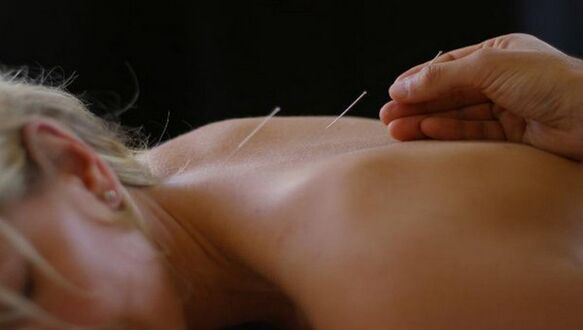
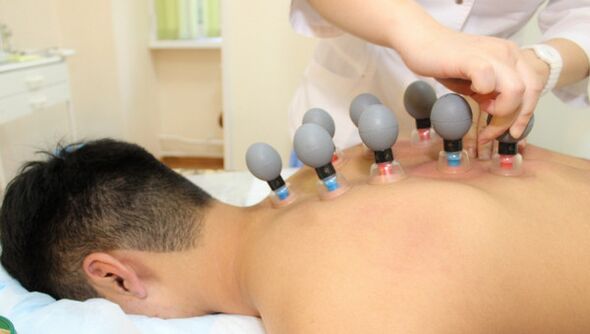
Back pain prevention.
If you enter the risk zone as a person whose spine is subjected to constant stress by the nature of the activity (hard physical work, sedentary work, leg work), you should do periodic warm-ups every day.
Also, you should follow the following tips:
- for a long-lasting position, lean on a vertical surface: a wall, a pillar, etc. ;
- when carrying weights, distribute them evenly; in both hands, it is better to wear a backpack in this case;
- bend your knees when lifting a heavy load off the floor;
- do not make sudden movements;
- watch the posture, do not stoop;
- maintain a normal body weight;
- do gymnastics, which includes curves and twists of the body;
- sleep on an orthopedic mattress;
- exclude sleeping on high pillows.
The most accessible and effective prevention methods are physical exercises to strengthen the back muscles, swimming, refusing to take the elevator and daily stair climbing and walking.

The simplest recommended exercises to strengthen your back muscles include:
- Hip bridge- in a supine position, bend your legs and lift your hips, lifting your pelvis off the floor. The body should be stretched in a straight line. Keep your hips taut in this position for a few seconds, then slowly return to the starting position. It is recommended to perform this exercise at least 12 times.
- Side table- Lying on the right side and leaning on the elbow, lift the body and stretch it in a straight line, lifting the hips off the ground. Do the same on the left side.
- Lunges- from a standing position, you alternately lunge forward with your legs, bending your legs at an angle of 90 degrees. Recommended 10 times.
- Deflection in the prone position- lying on your stomach, lean on your hands and raise your shoulders as much as possible.
- Ball crunches- lying on your back, wrap your hands around your knees and pull them towards your stomach. Lie down like this for 30 seconds. Then return to the starting position.
Fitball exercises are very effective for the back.
If you follow these recommendations, you will not be able to have back problems throughout your life. In case they occur, it is necessary to go to the hospital as soon as possible to start the treatment of the health problem that arose in time, without taking it to a chronic state.






















